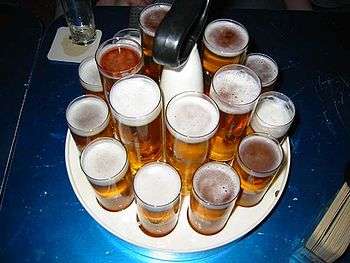Beer in Chile
| Part of a series on the |
| Culture of Chile |
|---|
 |
| History |
| People |
| Languages |
|
Traditions |
| Cuisine |
| Religion |
|
Music and performing arts |
|
Media |
| Sport |
|
Monuments |
|
Symbols |
|
The primary beer brewed and consumed in Chile is pale lager, though the country also has a tradition of brewing corn beer, known as chicha. Chile’s beer history has a strong German influence – some of the bigger beer producers are from the country’s southern lakes district (Los Lagos Region), a region populated by a great number of German immigrants during 18th and 19th centuries. Chile also produces English ale-style craft beers while also developing its own craft beer identity.[1]
History
There is long tradition of brewing a drink called chicha[2] that might be classified as corn beer by modern standards, though is not considered as such in South America. Chicha was originally brewed with corn, influenced by the Andean cultures of northern Chile and Peru, but during colonial times apple and grape chicha started to be brewed across the country as a cheaper alternative to wine. There were at least four major alcoholic drinks during colonial times in Chile: wine, pisco-aguardiente, apple chicha and grape chicha.
Modern beer (Spanish, cerveza chilena) history in Chile began in the 19th century when European beer was first introduced in the years after Chile gained independence.[3] With the arrival of German immigrants around 1850, massive beer production began. By the end of the 19th century, beer was consumed all over the country. Beer consumption and culture then spread across the country from cities with high immigrant populations such as Valdivia and Valparaíso. In 1907, 20 million litres of beer were produced in Valdivia.[4] By 1997, Chilean beer consumption reached 28 liters per year per capita.,[5] and by 2013 this had increased to 40 litres per year per capita.
Economy
Pisco, wine and rum are popular alcoholic drinks in Chile but there has been a slow increase in the sales of lager, pale ale from local microbreweries and imported pale lager. Although Chilean beer consumption is low compared to the rest of the South American region, beer is still the most consumed alcoholic beverage and takes 60% of the total market share for alcoholic drinks. Premium beers alone hold an 18% share of the total market, the highest share seen among the countries of the region.[6] Craft beers in Chile[7] Part of the so-called premium sector, craft beers have gained ground in recent years,[8] and today there are more than 300 micro-breweries in Chile. Cía Cervecerías Unidas SA, a local company, is the leading Chilean beer company, producing mainly lager beers.[9]
Some Chilean Beers
Cervecería Chile
Produce their own brands and also many of the best known international brands:[10]
- Baltica
- Becker
- Beck’s
- Paceña
- Malta del sur
Compañía de Cervecerías Unidas (CCU)
They produce their own brands of beer and some international brands, along with soft drinks and other alcoholic products.[11] Products include:
- Cerveza Cristal
- Escudo
- Dorada
- Royal Guard
- Heineken
Other brands
Other brands include:
- Austral, based in Punta Arenas, Austral is one of the oldest premium brands and produces different varieties.[12]
- Capital, from Batuco, north of Santiago[13]
- Grassau[14]
- Kross, claims to have won more prizes than any other Chilean brewery in the last two years.[15]
- Szot, from Talagante near Santiago[16]
- Del Puerto, from Valparaíso[17]
- Mestra, from Paine[18]
- Kunstmann, from Valdivia, Chile. One of the oldest breweries from southern Chile
- Rothhammer, from Santiago, Chile
See also
References
- ↑ Craft Beer in Chile www.beerandbrewer.com retrieved August 9
- ↑ Ancient Peru's ritual beer binges, BBC, July 31, 2004, sec. Americas. Retrieved 31 August 2008
- ↑ La cerveza en Chile en el sigrlo XIX
- ↑ Investigación aplicada sobre Geografía Urbana: Un caso práctico en la ciudad de Valdivia Víctor Figueroa, Jorge Gayoso, Edgardo Oyarzun, Lenia PlanasGestion Turistica, UACh.
- ↑
- ↑ Chile lidera consumo per cápita de cervezas premium Economía y Negocios, Constanza Rodríguez, June 05, 2013 retrieved August 8, 2013
- ↑ Las variedades de cervezas que presenta Chile cnnchile.com June 18, 2013, retrieved August 08,02013
- ↑ Five of Chile's best craft brewers www.thisischile.cl/ November 15, 2011, retrieved August 9, 2013
- ↑ euromonitor.com Retrieved 31 August 2008
- ↑ Cervecería Chile retrieved August 9, 2013
- ↑ Compañía de Cervecerías Unidas retrieved August 9, 2013
- ↑ Austral
- ↑ Capital retrieved August 8, 2013
- ↑ Cerveza Grassau retrieved August 9, 2013
- ↑ Kross retrieved August 9, 2013
- ↑ Szot retrieved August 8, 2013
- ↑ Del Puerto retrieved August 8, 2013
- ↑ Mestra retrieved August 8, 2013
